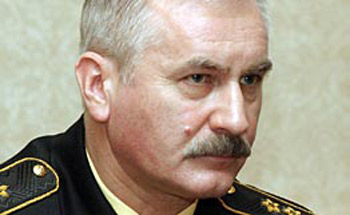
RUSSIAN ADMIRAL ANNOUNCES AMBITIOUS NAVAL BUILD-UP
Publication: Eurasia Daily Monitor Volume: 4 Issue: 155
By:

President Vladimir Putin appointed Admiral Vladimir Masorin commander of the Russian Navy in 2005. This year Masorin will turn 60 and, under Russian law, he must retire from active service. However, top generals and admirals may continue to serve in high command positions until age 65, if the president prolongs their duty by special annual decrees. Recently Masorin has been very active, making loud statements about plans to drastically increase naval power, perhaps hoping that greater visibility will help him keep his job.
Last May Masorin announced that Russia would resume building aircraft carriers in order to become a first-class naval power with a powerful ocean-going navy. Last month in an interview, Masorin explained that Russia would create an industrial base to make carriers and to train crews and pilots. Building starts in 2015 and by 2027 six carriers should be ready — three for the Pacific and three for the Atlantic (Rossiiskaya gazeta, July 10).
In Sevastopol last week, Masorin announced that Russia “must restore a permanent naval presence in the Mediterranean Sea,” using the combined forces of the Black, North, and Baltic Sea Fleets. During the Cold War Moscow maintained a permanent naval taskforce in the Mediterranean and today still has a naval supply station in Syria (RIA-Novosti, August 3).
In Russia today any call to restore former Cold War greatness and stature is applauded, but are Masorin’s plans only daydreams? On paper the Russian Navy today is, according to Masorin, almost at par with the U.S. Navy, which has some 300 ships. But Masorin concedes that in fact Russia is weaker (Rossiiskaya gazeta, July 10).
The exact battle readiness of the Russian Navy and the number of ships ready to sail and fight are state secrets. Still, there are unofficial estimates, based on leaked information: one carrier, five cruisers (two nuclear-powered), nine destroyers, and 12 ocean-going frigates are considered to be ready (www.lenta.ru, July 11). However, this estimate seems over optimistic, and the real number of ready ships (not counting submarines) may be 20 or less.
With such a small force dispersed among four different (Black, North, Baltic Sea and the Pacific Ocean) fleets, it will not be easy “to restore” a task force in the Mediterranean on “a permanent basis.” During the Cold War Soviet ships in the Mediterranean shadowed the U.S. Navy, ready to hit immediately. Soviet military advisers and combat troops, deployed at different times in Egypt and Syria, were directly involved in combat with the Israeli Defense Force. A Russian naval task force was deployed to deter a joint U.S.-Israeli attack on Arab and Russian forces.
At one time Russia was a direct participant in the Middle East conflict, but not anymore, although Moscow still has a small presence of advisers and service personnel in Syria. There is no need to deploy a Russian naval deterrent in the region. In any event, a force of two or three warships with no air cover (that is all Moscow could possibly “permanently” deploy) cannot on its own deter anyone in the region.
In communist times, Russia built five aircraft carriers. They were all made at a shipyard in Nikolayev, Ukraine, that has been independent since 1991. The Nikolayev shipyard is today politically unavailable and, anyway, not ready to resume carrier production. The five carriers were inferior — not seaworthy to the state of being almost fully non-operational. Three of them have been already sold abroad as scrap. The only one retained by the Russian Navy, the Admiral Kuznetsov, has turned out to be an inoperable wreck. Since its launch in 1989, it has mostly been in dock for repairs, seldom venturing out to sea, with each short voyage ending in serious breakdowns of its main engine and other systems. The Kuznetsov air wing of Su-33 fighters has rarely flown from the deck.
Russia cannot build a carrier, since it does not have a shipyard with a dock that can construct ships of such size. There have been reports that a facility capable of making carriers would be erected in Severodvinsk in the Russian North at the Sevmash shipyard, which has before specialized in making nuclear submarines (www.lenta.ru, July 4, 2006). Another former Soviet carrier, the Admiral Gorshkov, is being refurbished for India at Sevmash. The $1.5 billion contract to modernize the Gorshkov was signed in 2004, and the Indian Navy was hoping to get a fully operational carrier in 2008, complete with an air wing of MiG-29K jet fighters. Last week it was reported that Sevmash is unable to complete the Gorshkov on time and construction will not conclude before 2011. Sevmash Director General Vladimir Pastukhov was fired for the failure (Interfax, August 1).
According to reports, the Gorshkov’s equipment is awful and virtually all of it must be replaced. The money allocated by the Indians for the renovation has been spent, but the ship is not ready. Russia has asked the Indians to pay billions of additional dollars if they want to see the ship ever sail. In reality, Russia has never managed to construct a single seaworthy carrier for its own Navy and it would have been a miracle to suddenly make a suitable one for the Indians. More money will not help cover the lack of experience, materials, modern equipment, components, and know how.
The failure to live up to contract obligations to upgrade and re-equip the Gorshkov will surely undermine relations and worsen Russia’s chances to sign other new arms trade contracts with India. It also does not bode well for Masorin’s grand plans to use an abundance of petrodollars to re-equip the entire Navy, especially with carriers.




